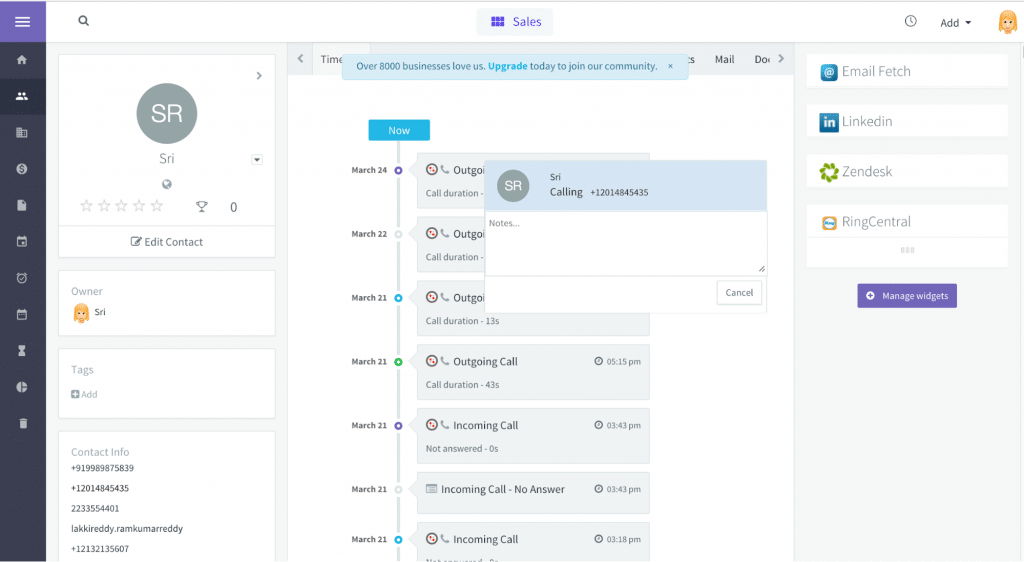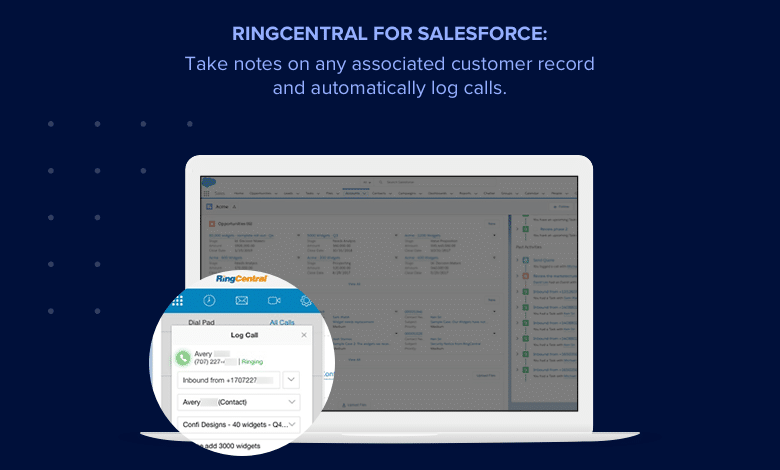Without sales call planning, your calls won’t have much success. You need to know as much as possible about your potential client, and even then, you should expect to be surprised. At any point, a sales call can become twisty and difficult to navigate. With that in mind, research and flexibility should be the two pillars that any good sales call is based on.
These days, some might ask why calling is important in sales. With the technology we have, some people might even question if it’s still effective. The answer to that? An emphatic yes.
In this article, we’ll look at:
- What sales calls are, exactly
- How to pre-plan for a sales call
- How to structure a sales call
- 3 types of sales calls
- Your secret weapon in sales call planning
Up your prospecting game and close more deals with these free cold calling scripts. ☎️
What are sales calls, exactly?
Sales calls are all about building up to a sale. This doesn’t mean that you have to make your sale while you’re on the call—in fact, that’s pretty rare. But a sales call is a great way to lay the foundations for future purchases.
Whether you’re having a first communication, calling with more details about your product, or closing a deal, you should always keep your objective firmly in mind.
Here’s a list of possible objectives you may have when calling:
- You want to create a good first impression.
- You want to build curiosity about your product or service.
- You want to upsell an existing client.
- You want the receiver to promote your product to their boss or colleagues.
- You want to renew a contract.
If you’re early on in the process, then it’s entirely possible that the person you’re talking to won’t be the one deciding to make the purchase. But that’s not a bad thing—if you’re talking to someone, you’re already on the way.
Sales call pre-planning
Before you make the call, do some research. Going into a sales call blind is a terrible idea: if your potential client realizes that you don’t know basic facts about their business, they won’t want to buy anything from you. It doesn’t matter how great your product is—without research, you might end up trying to sell Microsoft laptops to an Apple reseller, or something similarly absurd.
What information do you already have on your client, whether it’s about their company or existing interactions? If you’re not already using sales app like a CRM to track sales interactions with clients, you’re missing out. CRMs are a type of sales software that store client information as well as past interaction history, and are an essential tool in any sales rep’s arsenal.
And if you integrate your CRM with your calling tool (for example, Salesforce or HubSpot), you can even make calls more quickly directly from your CRM—just by clicking a phone number:

Calling from your computer screen using RingCentral’s integration with Agile CRM
Here are your three most important research subjects.
1. The company
This may seem obvious. But try to dig a little bit deeper when you’re researching your potential client. Find out about their target audience, their USP, their company goals. How can what you’re selling benefit them specifically? Even if your product has broad appeal, specific use cases can resonate with buyers.
What information does your CRM contain about the company? Make sure you’re not giving them the same sales pitch twice. If you or a colleague has already tried without success, then look at communication history and decide how to best alter your proposal.
2. The person you’ll be talking to
If possible, also try to find out a little bit about whoever you’ll be directly speaking with. Any information, whether it’s their previous work experience, their past roles at the company, or even outside interests, could help you forge a connection. Knowledge is power, and on a sales call, any insight into the receiver will support your objectives.
3. The company’s main competitors
This last point is important. If a client isn’t leading the market, finding out what their competitors are doing better could help you offer a way to catch up. If your potential client IS in the lead, that lead may be precarious, and you might have just what they need to stay ahead.
Look at their competitor’s USPs for any way that your product could overcome those advantages, and communicate it while on the call.
One more thing to keep in mind: know your own product’s weaknesses, so that if any potential concerns come up, you can do your best to remedy them.
How do you structure a sales call?
For all the reasons mentioned above, sales calls can be difficult to structure, mostly due to their inherent unpredictability. But don’t let that stop you from making a sales call checklist! A basic framework will help your call to be more effective.
Most people working at busy companies won’t want to spend time chatting on the phone, so you need to hook your prospect from the start. You could do this by mentioning a mutual acquaintance, reminding them of where you’ve met (if you’ve met), or by getting straight to the reason for the call.
Read the mood. If the person you’re talking to seems relaxed, then it’s okay to take it a little slower and throw in some humor. However, if they sound busy or stressed, then efficiency should be your approach. Tell them you have something that can help them—a solution to a problem they’re facing, the solution being your product.
Here’s an easy-to-use checklist that you can have ready for every sales call:
1. Give your prospect the hook
The hook will be unique to every call, and dependent on the planning and research you’ve put into this call. If you were in the client’s position receiving this call, what would you want to hear that would make you stay on the line?
2. Explain how your product can help
You know what the client needs, and you know that your product is a solution. Explain it clearly, but don’t go into too much detail at this point. You don’t know their specific use case and needs just yet.
3. Take time to listen
This is why you don’t want to over-explain: on any call, you also have to take time to listen to the client’s needs. Even with thorough research, you could learn new information that will influence your strategy or your objective.
After you’ve explained a little bit, let the client talk and ask questions, and think about how to reply. If your prospect senses that you’re just reading questions off a list, it could be off-putting.
4. Leave a positive impression
No matter the result of the call, always end it on a good note. Even if the receiver is abrupt and clearly doesn’t want to talk to you, a good impression might linger in their mind, and could leave the door open for future calls or opportunities.
3 types of sales calls
Here are the three basic types of calls that you’ll encounter in sales.
Cold calls
What it is: A cold call is an unsolicited call to a prospect. This is usually an introduction and the first step in the process.
How to plan for it: Research, research, research! What about this person or company makes them a good fit for your product? Build a good hook and give it to them. Then, depending on their level of interest, find out more and do your best to secure a follow-up call.
Warm calls
What it is: A warm call is a call made when the prospect has already shown interest. The prior introduction could have happened many ways: in person at a conference, through online messages, or through a referral, for example.
How to plan for it: Since the interest is already there, the hook has already taken place. Use warm calls as opportunities to continue building a relationship with the potential client, and to learn more about their needs. This gives you the perfect opportunity to describe how your product suits those needs.
Warm calls often double as follow-up calls. Don’t be afraid to call prospects again, especially if they’ve shown interest! People are busy, and sometimes, without a follow-up, your product might slip their mind. Sales are often lost due to a lack of following up.
Sales appointment calls
What it is: This is the deal-clincher type of call. In this call, the decision-maker will most likely be present, so this is your chance to close the deal.
How to plan for it: Get all the details right! If you’ve made it this far, it’s usually safe to assume that you know a fair bit about each other already. So have all your information ready, and give your prospect whatever supporting data they need to close the sale.
Your secret weapon in sales call planning: CRM integrations
CRM tools are important parts of the sales process. Here’s an example of how integrating CRMs with your communications can boost your sales impact.
Porch, a home improvement and maintenance company based in Seattle, Washington, uses Salesforce as their CRM tool. Knowing this, Porch wanted a communications platform that integrated with Salesforce.
So, they chose RingCentral Contact Center™. Because it’s an omnichannel contact center, Porch’s sales reps can see and access all client and prospect information through the Salesforce integration and use this information to plan for sales calls—and then call directly from RingCentral’s platform:
Salesforce is just one possibility. RingCentral integrates with more than 70 different CRM tools, and that number is growing all the time. Having the right information on hand can make all the difference!
Here’s a quick look at how RingCentral helps sales teams close more deals:
Ready to plan the perfect sales call?
Sales calls don’t always go according to plan. (Actually, most of the time, they probably don’t.) That’s exactly why it’s important to always have a plan.
With a little prep work and planning, you can make sales calls more efficiently—and effectively.
Ultimately, you’ll be rewarded with more follow-ups and more closed deals. Who doesn’t like that?
Originally published Mar 31, 2020, updated Feb 26, 2021






